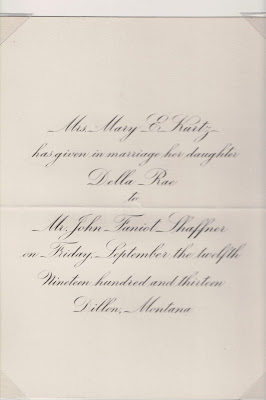#30 Easy. Grandpa Shaffner. 52 Ancestors in a Year
My easiest genealogy research has been my grandfather, John Faniot Shaffner. Grandpa lived to be 103 and loved his family history. He was born in Harrisburg,, Pennsylvania on 12 September 1887 and died in Dillon, Montana in 1991. He was a fixture in my life for 39 years.
Since Grandpa came west with the railroad, I was able to order his railroad retirement portfolio. In all the pages of information, the only thing I learned was when he went to work at his first job with a railroad in 1907 at a student telegrapher at McElhattan, Pennsylvania with the Pennsylvania Railroad. In 1912, he was with the Northern Pacific Railroad in the Yellowstone Division stationed in North Dakota. Eventually he moved to the Union Pacific in Dillon, Montana. He kept his typewrite and returned it to the Depot when he was a 102!
Grandpa homesteaded in Beaverhead County, so I ordered the homestead paperwork. He filed for land on 9 February 1916 and was given a patent for 480 acres on 17 June 1921. It was a huge file with lots of information! The size of the cabin, the struggled to prove up the homestead during the dry years of the ’20’s as well as the crops grown and harvested each year made for interesting reading!
One of his mysteries was where he kept all of his family history through the years. Especially in the homestead era as the cabin was not large.
He kept the announcement of his marriage in 1913; yes, the original with the envelope is in my possession!
Grandpa was very good to write his life story. Not once, but several times during his lifetime. And yes, the story was about the same each time he wrote it. He also wrote the story of his trip down the Susquannah River in 1910 when he was 99 years old!
Until the day he died, he regretted that he never took the family photo album from his dad. His dad remarried when Grandpa was 14 and then he went to live with an older sister as the new wife did not like her step children. (Grandpa Shaffner’s story). At some point, Grandpa did take the Family Bible and he stated that his father said that “Emma (the 2nd wife) would be mad”. What a treasure the Bible is with the births/deaths/marriage recorded. Loose papers in the Bible were another treasure written in a very old cursive style of writing, recording the births/deaths/ marriages of Grandpa’s Grandmother, Margaret Maria Fetter Shaffner. Unfortunately there is not information about John’s grandfather and great grandfather.
My Dad, Don Shaffner, with the Shaffner Family Bible
Grandpa liked taking pictures, buying postcards, and creating scrapbooks. Although pictures were sometimes blurry or heads cut off, the pictures in the scrapbook are labeled with names and sometimes dates. There is no order or rhyme or reason to the placement of pictures; there might be a 1913 pictures in a section of pictures from 1960!
He worked for many years with my cousin, Donnee Shaffner Stibal identifying people and labeling pictures.
Because of his love of family history, he kept in contact with many of his cousins and nieces and nephews, often making trip to visit them.
Grandpa’s love of history made genealogy research easier for me. So far, all his information has been fact checked and he was right! I am very thankful for all the wrote and the information and pictures that he kept.
His confirmation certificate from 1904!
Grandpa Shaffner (John Faniot Shaffner) on his 100th birthday




























